We liked the nori taste with tarako and potatoes. Either way (the original or this version), this is an excellent dish. We really like both versions.
Saturday, November 6, 2010
Julienned potatoes with spicy cod roe redux ジャガイモの明太子和え 再登場 (Mark's book p24)
We liked the nori taste with tarako and potatoes. Either way (the original or this version), this is an excellent dish. We really like both versions.
Thursday, November 4, 2010
Monkfish medallion sautéed with garlic and olive oil アンコウのニンニクオリーブオイル焼き
After making the monkfish karaage 唐揚げ, I made the remaining monkfish fillet into this dish the next day.
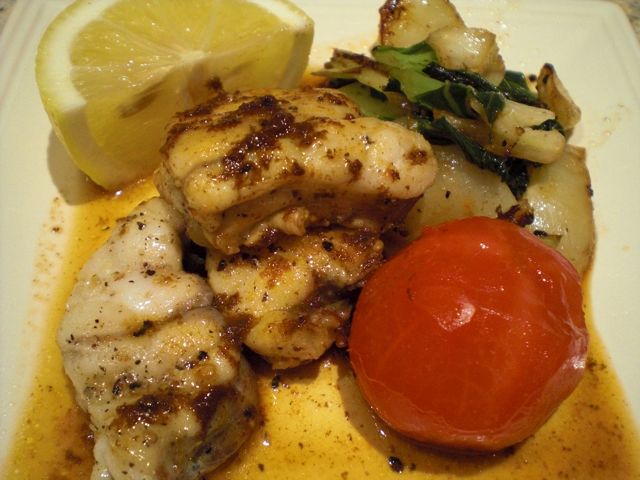
I made medallions of fish a bit less than 1 inch thick. I then marinated them in olive oil, lemon juice and 3-4 fat cloves of crushed garlic for 24 hours. Just before cooking, I removed the excess moisture from the surface of the medallions and lightly seasoned them with salt and pepper. In a frying pan on a medium flame, I added olive oil, and crushed garlic from the marinade and fried it until it became fragrant and slightly brown. I took the garlic out and set aside. I added the medallions of monkfish and cook them for 3-4 minutes and flipped them over. At this point, I added previously blanched Bok Choy which was cut into a bite sized pieces to the center of the pan, moving the medallions to the periphery to make room for the Bok Choy. I then put two thin pats of cold butter on the top of the Bok Choy and cooked it for another 3-4 minutes. The butter will melt very slowly. As the fish was about to finish cooking, I mixed the Bok Choy and butter and added just a small amount (1 tsp) of soy sauce and also add skinned Campari tomatoes to the pan for another minute or so and, at the very last moment, added back the garlic.
This is a sort of fusion dish and almost tastes like lobster tail. The rather assertive garlic flavor goes well with this fish. The tomatoes also exude some juice to form a small amount of sauce/liquid in the bottom of the pan. The flavors of soy sauce, butter, garlic and tomato add to the dish.
Tuesday, November 2, 2010
Chestnut rice 栗ごはん
Chestnuts are such a typical seasonal food item in Japan for deepening autumn. As a kid in Japan, we ate them every fall, usually boiled and it was something I generally liked. We had quite a few mature chestnut trees in our neighborhood. Many half open "Iga" いが or outer prickly shells were on the ground and getting chestnuts from those shells was always tricky for young kids. The trick was getting the nut without being pricked. In North America, because of Chestnut blight, most of the North American Chestnuts trees were wiped out by 1940. Chestnuts, maybe as a result, appear not to be a very popular food item. The vast majority of chestnuts we see here are imported from Europe (see P.S. below). My wife tells me that her childhood memory of chestnuts was the yearly ordeal (usually around Christmas) of roasting them in the shell over an open fire in the fireplace. While they smelled great, they weren't worth the bother. Once she busted into them, they were a major disappointment--dry, chalky, tasteless.

On one of our first trips to Japan as a married couple, we came across a roasted sweet chestnut vendor, "tenshin amaguri" 天津甘栗, under the raised railroad tracks in Shinbashi 新橋 area of Tokyo. The smell wafting from the cart was divine. I suggested we get some and my wife said, "Don't bother" and kept walking. I got them anyway and the smell enticed her to try some. She was astounded at how good they were. She insisted they couldn't be the same thing she ate as a child. Last week I found chestnuts in the shell at our gourmet grocery store. I, again, could not resist and got some chestnuts for a Japanese chestnut rice or "kurigohan" 栗ごはん. Again my wife advised, "Don't bother" and warned me that they would not taste like the ones I was used to.

I again used the earthenware rice cooker called "Kamado san" like I did when I made "Matsutake gohan", I used kelp soaked water and added sake (2 tbs) and salt (1 tsp) to make 400ml of the cooking liquid. I did not use soy sauce to prevent the rice from darkening. I washed and drained the rice (2 Japanese cups or 360ml). I added the rice and the liquid into the cooker, and placed cleaned chestnuts on the top (lower right in the above image). As per the instruction that came with the cooker, I put on the inner lid and then the outer lid. I cooked it on a medium high flame for 14 minutes and then let it stand for 20 minutes.
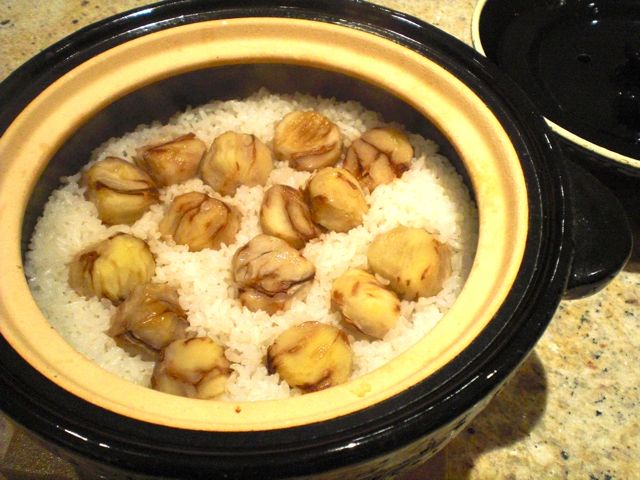
Here is the end product (above). I was a bit disappointed--I "shouldn't have bothered". The chestnuts were dry, chalky and pretty tasteless (as my wife predicted), although they were certainly edible. The rice itself was quite nice. We may try this again with bottled boiled chestnuts from France next time. But at least, I feel like I paid some respect to autumn, which has firmly arrived here.
P.S. After I posted this, an interesting article appeared in Washington post regrading chestnuts including different types and origins of the chestnuts imported here.
I first soaked the chestnuts (15 or so, upper left in the image below) in water for several hours to make it easier to peel the outer hard skin. You could also parboil to make it easier to remove the skin. It is easy to take off the hard skin called "onikawa" 鬼皮 by cutting off the bottom and peeling off the hard skin but the chestnuts are still covered with the bitter-tasting inner skin (upper right). The most labor intensive part is removing the inner skin called "shibukawa" 渋皮 meaning "bitter skin". I just used a small paring knife to remove the inner skin but it is not easy. I put these cleaned chestnuts into water to prevent discoloration (lower left).
P.S. After I posted this, an interesting article appeared in Washington post regrading chestnuts including different types and origins of the chestnuts imported here.
Sunday, October 31, 2010
Flounder simmered in Japanese broth カレイの煮付け
I do not think I ever made this dish before. Probably because I somehow associate this dish with being ill as a kid. This was the first solid food my mother served me when I was recovering from some GI ailment. My mother thought this dish was the most mild flavored, easily digestible and highly nutritious food she could serve to speed recovery. All this is probably true but I can't imagine feeding this to an American kid just getting over a tummy ache.
I bought too much fluke (flounder) which I used in my matsutake dish. I thought about making menier or grilled or fried flounder but I decided to make this dish. One of the reasons I chose this dish is because I had extra kelp broth left over from when I made matsutake rice.
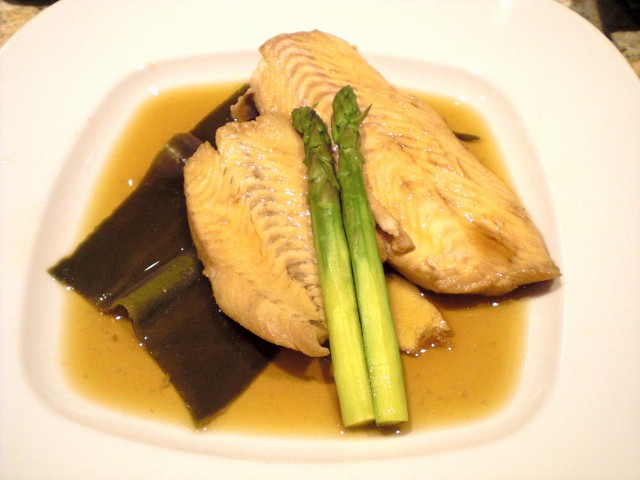
The different Japanese and English names for flatfish are numerous and confusing. I usually associated the Japanese name "Karei" カレイ 鰈 (The left symbol which makes up this kanji letter is "fish魚" and the right symbol is "leaf葉") with sand dabs and "Hirame" 平目 (meaning "flat eye") with flounder or fluke but I am not sure this is a correct association. A classic Japanese recipe calls for small sand dabs or karei for this dish so that the whole fish with skin on is simmered in broth (see image below). The skin adds a slightly slimy texture which, I suppose, the Japanese like but I only had previously skinned and boned fillets of flounder.
Here is a more classic image of "Karei no nituske" カレイの煮付け(http://www.jf-net.ne.jp/kagyoren/image/santi/12-6.jpg)
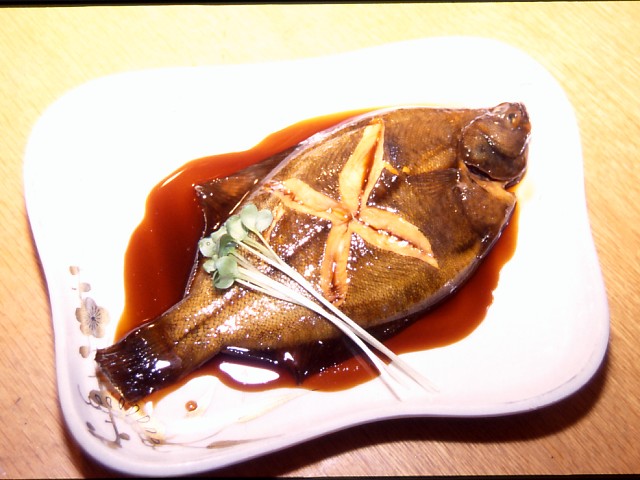
I bought too much fluke (flounder) which I used in my matsutake dish. I thought about making menier or grilled or fried flounder but I decided to make this dish. One of the reasons I chose this dish is because I had extra kelp broth left over from when I made matsutake rice.
Broth: Again, this is typical Japanese seasoning combination. I used kelp dashi, sake, mirin, and soy sauce (2:1:1:1). If you like you could add sugar (up to 1 tbs) to this. You must add enough slices of fresh ginger (3-4 thin slices) to add a good ginger flavor to this dish. I placed the seasoning liquid in a flat wide pan like a sauté pan so that the fillets are in a single layer and covered with the seasoning liquid. I gently simmered it for 10 minutes. Since this was a fillet, I did not bother with "otoshi buta" 落とし蓋 but instead, I covered it with a piece of kelp while the fish was cooking.
I served the fish with the kelp on the bottom (as decoration, just becase I had it) and boiled asparagus. I had to admit, this is not one of my favorites but it has a nice gentle texture and the taste of fresh ginger. Oddly, I am already feeling better.
Here is a more classic image of "Karei no nituske" カレイの煮付け(http://www.jf-net.ne.jp/kagyoren/image/santi/12-6.jpg)
Friday, October 29, 2010
Braised potatoes and green beans 小芋とインゲンの煮物
This is a very homey and simple dish. My mother used to make it often. I made this one evening since my wife washed and dried green beans but did not have a time to make the dish she had in mind and was in the process of putting them away in the refrigerator. I just grabbed a handful of green beans and made this dish.

One of the problems I have is that I do not measure anything especially for this kind of dish The amount of ingredients and seasoning is just a guesstimate. The above picture is the entire amount I made; about 20 green beans and 6-7 baby red potatoes.
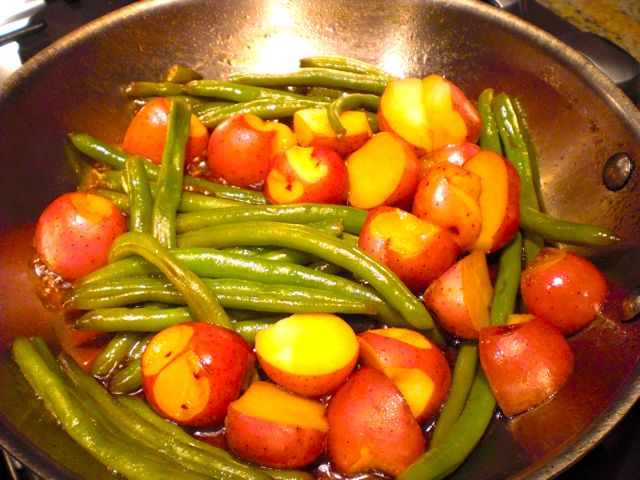
This is a somehow very comforting dish for me since it was one of my mother's repertoire. Classic Japanese seasoning but the fresh taste of green beans comes through. Perfect side for any Japanese meal or you could have it by itself with sake like we did.
I removed the "eyes" of the potatoes and cut them in half or quarters depending on their size. In a large frying pan on a medium flame, I added 1/2 tbs of vegetable oil and a splash of dark roasted sesame oil. When the oil was shimmering, I added the green beans (please make sure they are dry, otherwise it splatters) and the potatoes and sautéed briefly so that all the vegetables are coated with oil. I added 2-3 tbs of mirin and tossed it around. After 1 minute or so I added chicken broth (3-4 tbs, non-fat and reduced sodium Swanson as usual but you can use dashi, sake, or water). I put on a tight fitting lid and turned down the flame to a low simmer. I let it cook for 10 minutes or so and added 1 tbs of soy sauce. I put back the lid and simmered it for another 5-7 minutes. I opened the lid and checked the potatoes to see it they were done (insert a skewer or knife tip). If the potatoes are not done and not much liquid is left, add more water or chicken broth. (In my case, the potatoes were done). The liquid should be reduced quite a bit at this point (Picture below). I added a half tbs more soy sauce (to give a fresh soy sauce flavor) and tossed it around and let the liquid evaporate almost completely (another 1 to 2 minutes).
Wednesday, October 27, 2010
Tuna "namerou" tartar 鮪のなめろう
I have done posts about frozen yellow-fin tuna sashimi block or "saku" 冊 previously several times. Although it is by no means quality tuna sashimi, it is very convenient to have in your freezer and affordable. My quest to make this frozen tuna palatable continues. This evening, I made three different dishes--one of them I attempted for the first time.
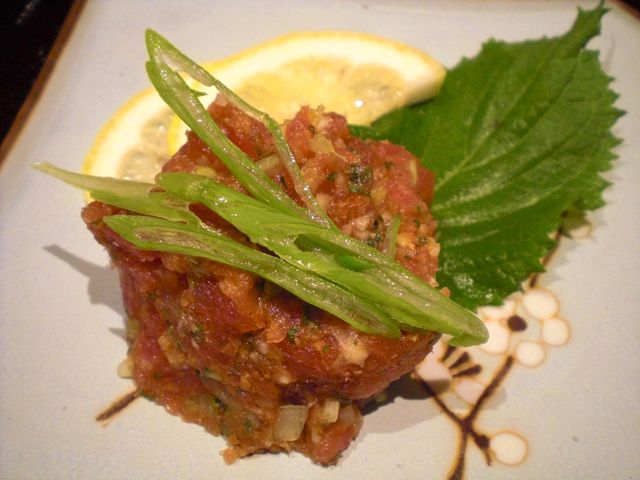

This is variation of "zuke" 漬け. Last time I made it, it was very good but, for me, it was a bit too salty, so I made some modifications to make it more like slightly flavored sashimi than a classic "zuke" preparation. I used the same type of marinade but increased the amount of sake and mirin (sake, mirin, regular dark soy sauce and usukuchi syouyu in 2:2:1:1 ratio). I also added ginger juice (from freshly grated ginger root), and coarsely ground roasted white sesame as before. I also did a "shimofuri" 霜降り process and then marinated it for 2 hours in the refrigerator. This is not quite "zuke" and the consistency of the tuna did not change too much to the point of "sliminess" like in a classic "zuke" preparation. The marinade did impart nice flavors and the consistency of the tuna was quite good. I sort of like this preparation. So far, two solid hits for me tonight--one more to follow, bases loaded. Actually, at this point, probably more than just "bases" are loaded. These two dishes are so perfect with sake we may be "enjoying" ourselves too much at this point.

This is called "namerou" なめろう. It is a type of "tataki" たたき or Japanese style tartar type preparation. I am not sure of the origin of the name but "nameru" なめる means "to lick". This dish was said to be made by a fisherman on the boat, simialr to the origin of "okizuke" 沖漬け. The fish used in this dish is usually a blue-white shiny skinned fish, "hikarimono" ひかりもの, such as mackerel. Tuna is not commonly used but I made this with the frozen tuna.
I used about 1/3 saku since I made three different dishes shown here. I first roughly chopped the tuna into small cubes, sliced scallion, minced perilla and fresh ginger (amounts all arbitrary). I added half a tsp of red miso paste to start. I minced (or "tataku", meaning to bang or hit with a knife blade) all these together until it became sticky and well mixed but still retained some shape. I tasted it and added a little more miso to finish. If this becomes too stiff, you could add a small amount of sake to make it the right consistency, which I did not need to do. This was a great success! Because of the many flavors especially the miso and the nice consistency, it was perfect to nibble while sipping cold sake. If you were not told, you would not be able to tell that this was made of frozen yellow-fin tuna.
The third tuna dish is our usual stand-by and is nothing new; just classic "yamakake" やまかけ.
We think, even for frozen saku of yellow-fin tuna, these three dishes I made tonight were quite good (I know my standards may have fallen substantially compared to those of Japanese food connoisseurs out there, especially a few in Tokyo).
Monday, October 25, 2010
Brie and Fuji Apple quesadilla ブリィチーズとリンゴのケサディア
This is a very interesting quesadilla. I bet you will not get this in Mexico but it is perfect with wine. We saw this in "Cooking Light" (paper copy) and both my wife and I independently thought it was interesting. Although the recipe came form "Cooking Light", by no means, is this dish "light".
I spread a thin layer of Dijon mustard (Grey Poupon) on one side of both tortillas. In a small (8 inch) frying pan on low flame, I add 1 tsp of olive oil and placed the first tortilla with the mustard side up and placed slices of brie on the tortilla. After the cheese started melting, I placed thinly sliced Fuji apple on the cheese to cover the surface (I peeled and cored the apple before slicing) and a handful of arugula on the top. I sprinkled freshly cracked black pepper over it. I then placed the other tortilla with the mustard side down. I pressed gently with a spatula. After few minutes, I flipped it to brown the other side and cook it for 2-3 more minutes.
As you can see in the above image, melted brie started oozing out as I tried to cut it. The unique combination of goat milk brie, mustard, black pepper, apple (still crispy, sweet and sour) and slightly peppery arugula, all works together. The goat milk brie had a very pleasant somewhat "gamey" flavor. This was a very nice Franco-Mex (?) hors d'oeuvre indeed, which goes particularly well with wine. We had this with red wine but any white, particularly something like Riesling will also do.
Subscribe to:
Posts (Atom)
